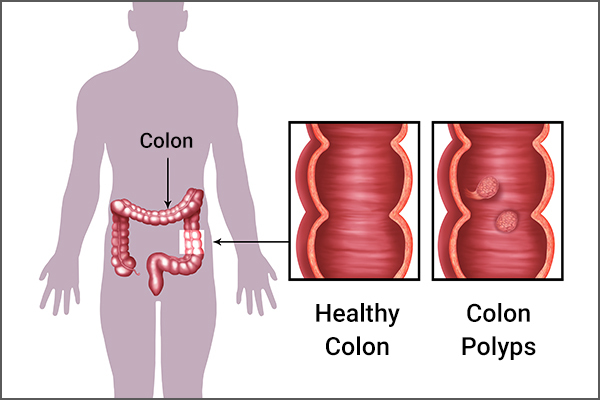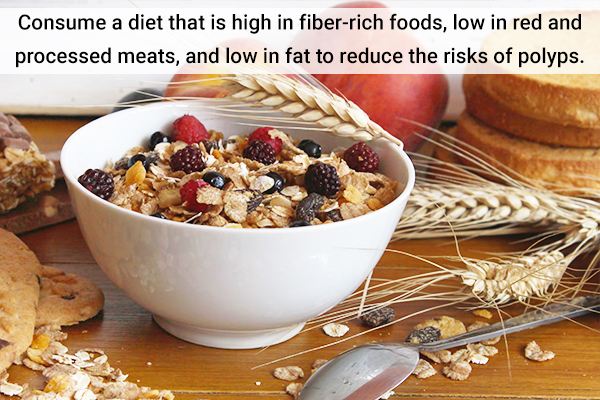In this article:
Polyps are growths that appear as bumps on the lining of the colon. Although they are usually benign, some may become malignant over time, so it’s best to get them removed to avoid the risk of colorectal cancer.

Types of Colon Polyps
There are four different types of polyps that are commonly found in the colon, namely, adenomas, hyperplastic polyps, hamartomas, and inflammatory polyps. (1)
- Adenomas are precancerous, which means they can develop into cancer over several years if not removed.
- Hyperplastic polyps are a common type of serrated polyp that is typically extracted and examined for cancer cells.
- Hamartomas generally don’t pose a cancer risk.
- Inflammatory polyps are also referred to as pseudo polyps or false polyps because they develop when your colon reacts to another underlying condition. They are composed of abnormal cells that become inflamed to form bumps on the colon lining.
Causes and Risk Factors for Colon Polyps

Hereditary and environmental factors contribute to the development of colon polyps. Several gene mutations are associated with an increased risk for this condition.
- The risk of developing polyps increases with age; 90% of polyps are found in individuals greater than 50 years of age. (2)
- Smoking, obesity, alcohol intake, a high-fat diet, red meat consumption, and a low-fiber diet can increase the risk of developing colon polyps.
- African-Americans and people with inflammatory bowel disease are at a higher risk of developing colorectal cancer. (2)
Symptoms Associated With Colon Polyps
In most cases, there are no symptoms associated with having colon polyps. The presence of symptoms is dependent on the size and location of the polyp.
However, symptoms that could warrant checking the colon for cancer outside of the general guidelines include:
- Rectal bleeding
- Abdominal pain
- Change in bowel function
- Unexplained weight loss
Treatment for Colon Polyps
The best treatment plan for polyps is to commence with colon cancer screening at age 45 for the average-risk patient without any symptoms. (3)
Most commonly, polyps are removed during a colonoscopy. Larger polyps can be removed surgically as well.
Diagnosing Colon Polyps

Polyps can go undetected for a long time as they rarely present any symptoms. Delayed diagnosis can be dangerous if the growth turns cancerous in the meantime, but it usually takes several years for a benign polyp to turn malignant.
To be on the safe side, everyone is recommended to undergo periodic colon cancer screening, which may involve a colonoscopy, checking the stool for blood or cancerous cells, or a CT (computerized tomography) of the colon.
The gold standard for catching polyps is colonoscopy. (4) The recommended screening interval is as follows:
- People who have never had polyps in the past and have no family history of colon cancer or polyps (average risk) should go for a colonoscopy every 10 years.
- For people with polyps, the interval can vary from 1 to 5 years depending on the number of polyps, quality of the examination, and type of polyp removed.
Tips to Reduce the Risks of Polyps

You cannot prevent polyps but you can reduce the risks of polyps by:
- Consuming a diet that is high in fiber-rich foods, low in red and processed meats, and low in fat
- Losing weight (helpful)
- Not drinking alcohol in excess
- Quitting smoking
Hereditary Polyp Disorders
There are several inherited colorectal cancer syndromes, including the following:
1. Lynch syndrome (hereditary nonpolyposis colorectal cancer syndrome)
Lynch syndrome is associated with germline mutations in the DNA mismatch repair (MMR) genes and accounts for most cases of hereditary colorectal cancer (CRC). (5)
Colorectal cancers occur at an early age (30s to 40s). There is also an increased risk of uterine, ovarian, stomach, small intestine, and renal/ureter cancers.
2. Familial adenomatous polyposis
Colorectal cancers occur in the 20s in nearly 100% of the affected patients. The colon has hundreds to thousands of polyps in these patients starting in early adolescence. (1)
3. Juvenile polyposis syndrome
Multiple hamartomatous polyps are present throughout the gastrointestinal tract. Hamartomas are benign polyps composed of normal and abnormal cells from the area of the body where the polyp is found. There is an increased risk of gastric and colorectal cancers.
4. Cowden syndrome

Multiple hamartomas are present in different parts of the body including the skin and mouth. There is an increased risk of breast, uterine, thyroid, kidney, and colorectal cancers. (6)
5. Li-Fraumeni syndrome
This disorder is commonly associated with sarcoma (cancer of the skeletal muscle), breast cancer, leukemia, and cancer of the adrenal glands. The risk of colorectal cancer is also increased.
6. Attenuated familial adenomatous polyposis
As compared to familial adenomatous polyposis, attenuated FAP occurs at a later age, and the polyps are found more often in the upper or right side of the colon. All of the patients affected with this disorder eventually develop colon cancer.
7. Peutz-Jeghers syndrome
The patients have two or more hamartomatous polyps of the gastrointestinal tract. Pigmented spots are present on the mouth, lips, nose, eyes, genitalia, or fingers.
8. Serrated polyposis syndrome
The patients have more than 20 serrated adenomatous polyps that vary in size and location within the colon.
How Long Does It Take for a Polyp to Turn Into Cancer?
Typically, it takes up to 10 years for a benign polyp to develop into cancer.
Final Word
If you are prone to developing colon polyps or if this condition runs in your family, consult your doctor about the necessary precautions to catch them early.
If a polyp goes untreated for a long time, it runs the risk of turning cancerous. Based on your medical history, your doctor will recommend what types of tests you need to undergo and how often to catch any new growth in your colon.
- Was this article helpful?
- YES, THANKS!NOT REALLY


